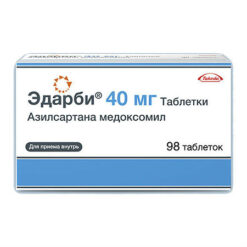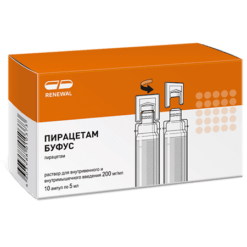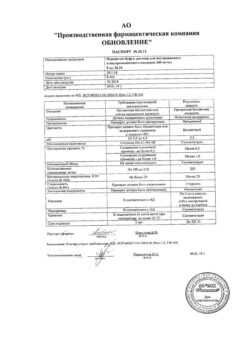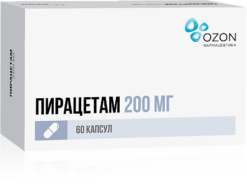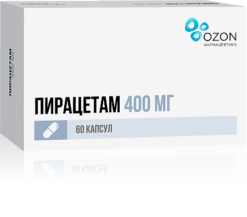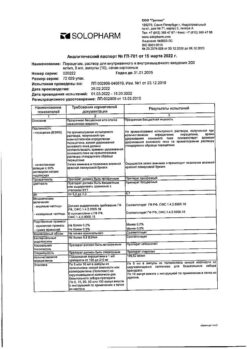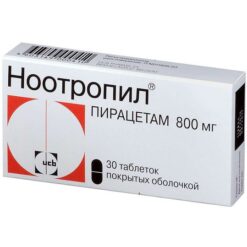No products in the cart.
Piracetam, 400 mg capsules, 20 pcs.
€1.00
Out of stock
(E-mail when Stock is available)
Description
Piracetam activates associative processes in the central nervous system, improves mood, memory and mentality in sick and healthy people. It stimulates intellectual activity and integrative activity of the brain, facilitates learning processes, improves connections between hemispheres of the brain and synaptic conduction in the cortex, increases mental performance, stabilizes and restores impaired brain functions (memory, consciousness, speech). Piracetam normalizes the ratio of ADP and ATP (inhibits nucleotide phosphatase and activates adenylate cyclase), increases phospholipase A activity, stimulates bioenergetic and plastic processes in nervous tissue, and accelerates neurotransmitter exchange.
Piracetam increases resistance of brain tissue to toxic influences and hypoxia, increases the synthesis of phospholipids and nuclear RNA, and increases glycolytic processes and glucose utilization in the brain. Piracetam blocks platelet aggregation, improves microcirculation, optimizes the ability of red blood cells to pass through microvessels and the conformational properties of the red blood cell membrane, increases regional blood flow in ischemic brain areas. Piracetam increases EEG beta and alpha activity and decreases delta activity. It reduces vestibular nystagmus. During hypoxia, intoxication, trauma, electroconvulsive effect has a neuroprotective effect.
In connection with antihypoxic action piracetam is effective in complex treatment of myocardial infarction. Anxiolytic and sedative effects of piracetam are absent.
Piracetam is almost completely and quickly absorbed after oral administration. Bioavailability is 100%. When oral administration of 2 g of the drug the maximum concentration in plasma is 40-60 mcg/ml after 30 minutes. Piracetam does not bind to plasma proteins. After 2-8 hours the maximum concentration in the cerebrospinal fluid is reached. Piracetam penetrates all tissues and organs, penetrates through the placental barrier. It is almost not metabolized. It accumulates selectively in cerebral cortex, mainly in parietal, frontal and occipital lobes, basal ganglia and cerebellum. Half-life of piracetam from plasma is 4-5 hours; from cerebrospinal fluid it is 6-8 hours. More than 95% of the drug is excreted unchanged by the kidneys after 30 hours. The elimination half-life is longer in patients with renal insufficiency.
Indications
Indications
Chronic cerebrovascular insufficiency (hypertension, atherosclerosis, vascular parkinsonism), which is accompanied by impaired attention, memory, speech, headache and dizziness;
ischemic stroke and its consequences;
psychoorganic disorders;
dementia (senile dementia, Alzheimer’s disease, vascular dementia);
traumatic brain injury;
acute viral neuroinfection;
intoxication (recovery period, comatose and subcomatose state);
diseases of the nervous system, which are accompanied by a decrease in the level of wakefulness, intellectual-mnestic functions, behavioral disturbances and emotional-volitional sphere;
dizziness;
vestibular nystagmus;
lethargic state;
aphasia;
cortical myoclonus;
epilepsy (as an adjuvant);
senile and atrophic processes;
depressive conditions that are resistant to treatment with antidepressants;
prevention or elimination of neurological, somatovegetative, mental complications of treatment with antipsychotics and other psychotropic drugs;
neurotic depression with a predominance in the clinical picture of senesto-hypochondriacal and asthenic disorders, adynamia, and phenomena of ideomotor retardation;
psychoorganic syndrome in chronic alcoholism;
relief of pre- and delirious, withdrawal states in drug addiction and alcoholism;
acute intoxication with morphine, ethanol, amphetamine, barbiturates;
in children – cerebral palsy, consequences of perinatal damage to the central nervous system, mental retardation, low learning ability in psychoorganic syndrome, speech disorder, mental retardation, memory impairment, cerebrovascular disease, intellectual disability;
sickle cell anemia (as part of complex treatment).
Pharmacological effect
Pharmacological effect
Piracetam activates associative processes in the central nervous system, improves mood, memory and mentality in sick and healthy people. Stimulates intellectual activity and integrative activity of the brain, facilitates learning processes, improves connections between the cerebral hemispheres and synaptic conduction in the cortex, increases mental performance, stabilizes and restores impaired brain functions (memory, consciousness, speech). Piracetam normalizes the ratio of ADP and ATP (inhibits nucleotide phosphatase and activates adenylate cyclase), increases the activity of phospholipase A, stimulates bioenergetic and plastic processes in nervous tissue, and accelerates the exchange of neurotransmitters.
Piracetam increases the resistance of brain tissue to toxic influences and hypoxia, enhances the synthesis of phospholipids and nuclear RNA, enhances glycolytic processes and glucose utilization in the brain. Piracetam blocks platelet aggregation, improves microcirculation, optimizes the ability of red blood cells to pass through microvessels and the conformational properties of the red blood cell membrane, and increases regional blood flow in ischemic areas of the brain. Piracetam increases beta and alpha activity on the EEG and decreases delta activity. Reduces vestibular nystagmus. During hypoxia, intoxication, trauma, electroconvulsive effects have a neuroprotective effect.
Due to its antihypoxic effect, piracetam is effective in the complex treatment of myocardial infarction. Piracetam does not have anxiolytic or sedative effects.
Piracetam is absorbed almost completely and quickly after oral administration. Bioavailability is 100%. When 2 g of the drug is taken orally, the maximum plasma concentration is 40–60 mcg/ml after 30 minutes. Piracetam does not bind to plasma proteins. After 2–8 hours, the maximum concentration in the cerebrospinal fluid is created. Piracetam penetrates into all tissues and organs, and penetrates the placental barrier. Almost not metabolized. Selectively accumulates in the cerebral cortex, mainly in the parietal, frontal and occipital lobes, basal ganglia and cerebellum. The half-life of piracetam from plasma is 4–5 hours; from the cerebrospinal fluid is 6–8 hours. More than 95% of the drug is excreted unchanged by the kidneys after 30 hours. In patients with renal failure, the half-life is prolonged.
Active ingredient
Active ingredient
Piracetam
Composition
Composition
Active ingredient:
piracetam 400 mg;
Excipients:
colloidal silicon dioxide – 3 mg;
Capsule cap:
gelatin – 24.395 mg;
methyl parahydroxybenzoate – 0.236 mg;
propyl parahydroxybenzoate – 0.059 mg;
sodium lauryl sulfate – 0.023 mg;
dye “Sunset” yellow – 0.0861 mg;
crimson dye (Ponceau 4R) – 0.2118 mg;
brilliant blue dye – 0.2112 mg
Capsule body:
gelatin – 39.68 mg; methyl parahydroxybenzoate – 0.384 mg; propyl parahydroxybenzoate – 0.106 mg; sodium lauryl sulfate – 0.038 mg; titanium dioxide – 0.507 mg; crimson dye (Ponceau 4R) – 0.160 mg; Azorubine dye – 0.106 mg
Pregnancy
Pregnancy
Taking piracetam is contraindicated during pregnancy. When using piracetam, you must stop breastfeeding, as the drug passes into breast milk.
Contraindications
Contraindications
Hypersensitivity (including to pyrrolidone derivatives), severe renal failure (with creatinine clearance less than 20 ml/min), hemorrhagic stroke, Huntington’s disease, agitated depression, breastfeeding, pregnancy, age under 1 year.
Side Effects
Side Effects
Nervous system and sensory organs: hyperkinesia, drowsiness, increased irritability, depression, agitation, asthenia, aggressive behavior, dizziness, sleep disorder, headache, tremor, increased sexuality;
Digestive system: nausea, diarrhea, vomiting, abdominal pain;
Metabolism: increase in body weight;
Circulatory system: exacerbation of coronary insufficiency, arterial hypertension or hypotension;
Skin: hypersensitivity reactions.
Interaction
Interaction
Piracetam enhances the effects of indirect anticoagulants, psychostimulants, and the central effects of thyroid hormones (anxiety, tremor, sleep disturbance, irritability, confusion). The severity of extrapyramidal disorders increases when piracetam is taken together with antipsychotics.
Overdose
Overdose
An overdose of piracetam increases the side effects.
Treatment: gastric lavage, taking activated carbon, symptomatic treatment; There is no specific antidote; hemodialysis is possible (effectiveness is 50–60%).
Storage conditions
Storage conditions
In a dry place, protected from light. Keep out of the reach of children.
Shelf life
Shelf life
3 years
Manufacturer
Manufacturer
Sintez, Russia
Additional information
| Shelf life | 3 years |
|---|---|
| Conditions of storage | In a dry place protected from light. Keep out of reach of children. |
| Manufacturer | Sintez OAO, Russia |
| Medication form | capsules |
| Brand | Sintez OAO |
Other forms…
Related products
Buy Piracetam, 400 mg capsules, 20 pcs. with delivery to USA, UK, Europe and over 120 other countries.


